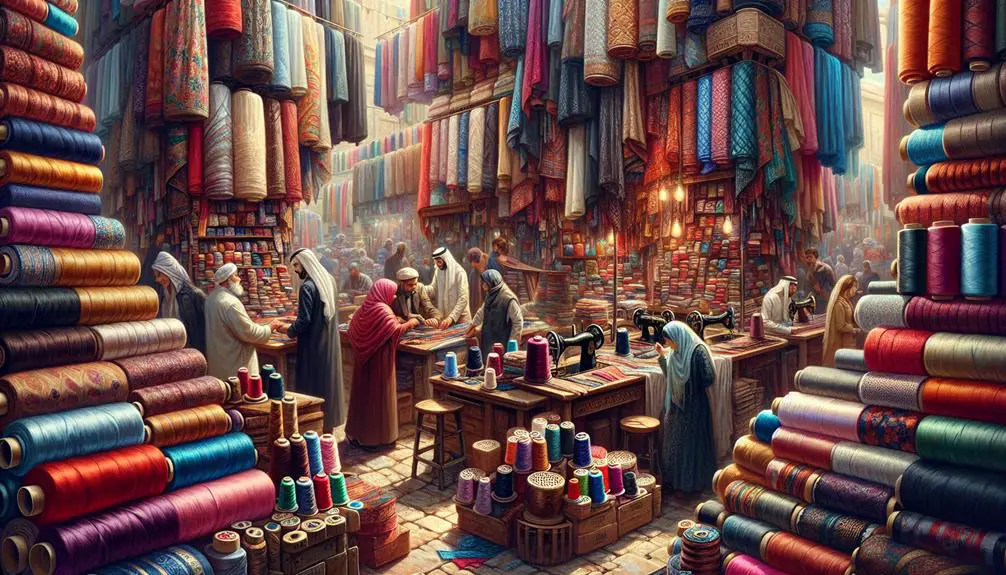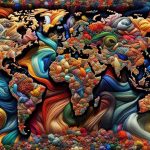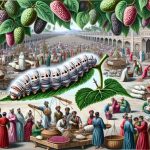When you look at the fabric industry, it's clear that its economic impact spans far beyond mere clothing. Fabrics have been central to trade, from ancient Silk Road exchanges to modern-day global markets, creating jobs and driving innovation across various sectors. Have you ever considered how the demand for textiles influences market trends or the development of sustainable practices? Exploring the economic role of fabrics uncovers their substantial contributions to job creation, trade dynamics, and technological advancements. But what are the deeper implications of these contributions in today's evolving industry landscape?
Table of Contents
Key Takeaways
- Fabrics have historically driven economic growth through trade, employment, and technological advancements.
- The fabric industry creates millions of jobs globally, spanning agriculture, manufacturing, and retail.
- Trade policies and international agreements significantly influence the fabric market's global dynamics and competitiveness.
- Technological innovations in fabric production enhance efficiency, functionality, and environmental sustainability.
- Rising consumer demand for eco-friendly and ethically produced fabrics is reshaping market trends and supply chains.
Historical Significance of Fabrics
Fabrics have played a pivotal role in shaping cultures and economies throughout history. You can trace the textile evolution back to ancient civilizations, where fabrics weren't merely utilitarian but also symbols of status and identity.
Think of the intricate silk garments of China or the vibrant, handwoven textiles of the Andes. Each piece tells a story, reflecting the cultural significance imbued in their creation.
You'll find that textiles acted as a medium for cultural exchange and technological advancement. For instance, the Silk Road wasn't just a trade route; it was a conduit for sharing techniques and traditions, elevating the craft across continents. By understanding these historical contexts, you gain deeper insights into how fabrics influenced social structures and economies.
Moreover, fabrics often held monetary value, functioning as trade goods and even currency in some instances. The demand for high-quality textiles spurred technological innovations, such as the spinning wheel and loom, which revolutionized production processes.
Fabric Industry Sectors
Delving into the fabric industry sectors, you'll encounter a diverse range of specialized fields, each playing an essential role in global commerce. Central to this vast industry is fabric production, a multifaceted process that transforms raw materials into the textiles integral to our daily lives.
The textile industry encompasses various sectors, including fiber production, fabric manufacturing, finishing, and distribution.
As you explore these sectors, you'll realize how fiber production forms the foundation, with natural fibers like cotton and wool and synthetic ones such as polyester and nylon. The next critical phase, fabric manufacturing, involves spinning fibers into yarns and weaving or knitting these yarns into fabrics. Each method yields unique textures and strengths, catering to different market needs.
In the finishing stage, fabrics undergo treatments to enhance properties like durability, colorfastness, and water resistance. This sector is crucial for meeting the high standards demanded by both consumers and industries.
Lastly, distribution ensures that these meticulously produced fabrics reach manufacturers, retailers, and ultimately, consumers worldwide.
Understanding these sectors offers a detailed view of how the textile industry operates, highlighting the intricate processes behind the fabrics that shape our world.
Job Creation and Employment
The fabric industry's extensive supply chain generates millions of jobs, from farmers growing raw materials to designers crafting the latest trends. By understanding this, you can grasp how deeply the fabric sector affects job creation and economic growth.
Each stage, whether it's cotton farming, textile manufacturing, or retail, offers diverse employment opportunities, fueling local and global economies.
You'll find that the industry's impact on employment is multifaceted. In agriculture, farmers and laborers cultivate raw materials like cotton, wool, and flax. As these materials move up the supply chain, they require processing by a skilled workforce in textile mills and factories. Here, workers spin, dye, and weave fabrics, creating essential jobs in both developed and developing nations.
This industry also fosters innovation and creativity. Designers, marketers, and retail staff play pivotal roles, ensuring the final products meet consumer demands.
Each job created leads to economic growth, as wages earned are spent within communities, boosting local commerce and businesses.
Global Trade Dynamics
When you look at the global trade dynamics of fabrics, you'll notice the significant impact of export market trends. Trade policies can either boost or hinder the fabric industry's growth.
Additionally, supply chain challenges often affect how efficiently fabrics reach international markets.
Export Market Trends
You might be surprised to learn how rapidly the global trade dynamics in fabric exports are evolving. Conducting an export market analysis reveals that consumer preferences are becoming more sophisticated and varied. With rising demand for sustainable and technologically advanced fabrics, countries that adapt quickly to these trends enhance their industry competitiveness.
You'll notice that nations like China, India, and Vietnam aren't just producing high volumes but are also focusing on innovation to meet global needs.
For instance, the push for eco-friendly materials has led to a surge in exports of organic cotton and recycled polyester. This shift influences global trade dynamics, as countries that can produce and export these materials efficiently gain a competitive edge.
Additionally, advancements in fabric technology, such as moisture-wicking and anti-microbial properties, are driving significant changes in consumer preferences, thereby altering export patterns.
Understanding these trends is essential if you aim to master the complexities of the fabric export market. By staying attuned to these evolving dynamics and consumer preferences, you can better predict market shifts and position yourself advantageously in the competitive landscape of global fabric trade.
Trade Policy Impacts
In recent years, trade policies have reshaped the global fabric market, altering both export opportunities and challenges. You need to understand how tariff impacts play a significant role in this dynamic.
When countries impose tariffs on imported fabrics, it raises the cost for importers and can make your products less competitive in those markets. Conversely, reduced tariffs can open up new avenues for your exports, allowing you to tap into previously inaccessible markets.
International relations are another pivotal factor. Trade agreements between nations can either facilitate or hinder your ability to move fabrics across borders. For instance, a free trade agreement might eliminate tariffs and quotas, giving you a competitive edge. On the other hand, trade disputes or sanctions can severely restrict your market access, forcing you to find alternative trading partners.
Being skilled at maneuvering these complexities can give you a strategic advantage. You must stay informed about current trade policies and anticipate changes that could affect your business. By doing so, you'll be better equipped to mitigate risks and capitalize on new opportunities in the ever-evolving global fabric market.
Supply Chain Challenges
Managing the complexities of trade policies is just one part of the equation; addressing supply chain challenges is equally essential to maintaining a competitive edge in the global fabric market. You've got to navigate demand fluctuations, sourcing issues, production delays, and rising transportation costs. These factors can disrupt your operations and erode profit margins if not managed adeptly.
First, let's tackle demand fluctuations. Unpredictable shifts in consumer preferences can leave you scrambling to adjust inventory levels. Accurate forecasting and flexible production schedules are essential to mitigate these risks.
Second, sourcing issues can hamper your ability to maintain quality and consistency. With raw materials coming from various global suppliers, geopolitical tensions or natural disasters can cause significant disruptions. Establishing diversified and reliable supplier networks is pivotal.
Third, production delays and escalating transportation costs can extend lead times and inflate expenses. Streamlining your logistics operations and optimizing your supply routes can help alleviate these pressures.
To stay ahead, you need to be proactive and strategic. Here's a quick recap of what you must focus on:
- Accurate demand forecasting and flexible production schedules
- Diversified and reliable supplier networks
- Streamlined logistics and optimized supply routes
Mastering these elements will put you in a strong position to thrive despite the challenges in the global fabric market.
Technological Innovations
You can't overlook how technological innovations are reshaping the fabric industry. Advanced textile machinery, smart fabric integration, and sustainable production techniques are at the forefront of this transformation.
You'll see how these innovations boost efficiency, enhance functionality, and reduce environmental impact.
Advanced Textile Machinery
Cutting-edge textile machinery has revolutionized fabric production, making it faster, more efficient, and highly customizable. You're now able to harness the power of textile automation and innovative materials to achieve unprecedented levels of precision and versatility. The integration of digital transformation in fabric manufacturing has paved the way for these advancements, allowing for seamless, streamlined processes that were previously unimaginable.
Here are three key areas where advanced textile machinery is making a significant impact:
- Automated Weaving and Knitting:
Automation has drastically reduced the time and labor involved in weaving and knitting, enabling you to produce complex patterns and textures with minimal human intervention. This not only boosts productivity but also guarantees consistency and quality.
- Innovative Material Processing:
New machinery allows for the manipulation of innovative materials, such as smart textiles and eco-friendly fibers, with ease. This means you can now create fabrics that aren't only functional but also sustainable, meeting the growing consumer demand for green products.
- Digital Fabric Printing:
Digital transformation in fabric manufacturing has brought about sophisticated printing technology. You can now produce vibrant, intricate designs directly onto fabric, offering unlimited customization options and minimizing waste compared to traditional methods.
Embrace these advancements to stay ahead in the competitive textile industry.
Smart Fabric Integration
Building on the advancements in textile machinery, integrating smart fabrics into your products brings a new dimension of interactivity and functionality. You can harness wearable technology to create garments that do more than just cover the body—they can monitor essential signs, adjust to environmental conditions, and even interact with other devices. Incorporating these innovations into your designs not only elevates the user experience but also positions you at the forefront of the fashion industry.
Smart fabrics are a game-changer, offering substantial health benefits. Imagine clothing that can track heart rates, detect dehydration, or monitor glucose levels. These capabilities can revolutionize healthcare, making it easier for individuals to manage their well-being without intrusive devices. Plus, with sustainability integration, you can ensure that your smart fabrics are eco-friendly, aligning with the growing demand for sustainable fashion.
Sustainable Production Techniques
Embracing sustainable production methods, manufacturers are now leveraging technological innovations to minimize environmental impact while enhancing efficiency. You'll find that sustainable fashion isn't just a trend; it's a revolutionary approach to reducing textile waste and fostering eco-friendly production methods.
Here are three key technological advancements driving this change:
- Advanced Recycling Technologies: These innovations allow you to transform post-consumer and post-industrial textile waste into high-quality fibers, promoting a circular economy. By converting waste into valuable resources, you're not only reducing landfill use but also conserving raw materials.
- Waterless Dyeing Techniques: Traditional dyeing processes consume vast amounts of water and release harmful chemicals. However, with waterless dyeing, you can achieve vibrant colors without the environmental footprint. This method significantly cuts down water usage and prevents water pollution, making your production process more eco-friendly.
- Digital Fabric Printing: This technology enables precise application of designs directly onto fabrics, minimizing fabric waste and excess dye usage. Digital printing ensures you can create intricate patterns with minimal environmental impact, aligning perfectly with the principles of sustainable fashion.
Market Trends and Consumer Behavior
As the fabric industry evolves, grasping how market trends and consumer behavior influence the demand for various textiles is crucial. Consumer preferences often steer market analysis, revealing that sustainability and ethical considerations are at the forefront. With the rise of sustainable fashion, industry growth is shifting towards eco-friendly materials and processes.
When you scrutinize consumer behavior, you'll notice that today's buyers are more well-informed and conscientious. They seek transparency from brands and insist on fabrics that align with their values. This shift requires that you concentrate on sustainable materials, as this trend is not merely a passing phase but a fundamental change in consumer priorities.
Here's a quick snapshot of current market trends:
| Trend | Consumer Behavior |
|---|---|
| Sustainable Fashion | Preference for eco-friendly materials |
| Transparency | Demand for supply chain visibility |
| Customization | Desire for personalized fabrics |
| Tech Integration | Interest in smart textiles |
| Ethical Production | Focus on fair labor practices |
Mastering these trends means staying ahead in the industry, ensuring your products meet the evolving demands. By comprehending and leveraging these insights, you can effectively cater to a market that's increasingly driven by conscientious choices and innovative fabrics.
Environmental and Ethical Impacts
The fabric industry greatly impacts both the environment and ethical standards, making it vital for you to understand these effects.
When you consider the environmental impact, you'll find that fabric production often involves significant water consumption, chemical use, and greenhouse gas emissions.
Ethical practices, on the other hand, are essential for ensuring fair labor conditions and reducing exploitation in textile factories.
To grasp the full picture, let's break it down into three main areas:
- Water Usage: Textile manufacturing is one of the largest consumers of water globally. For instance, producing a single cotton t-shirt can require up to 2,700 liters of water. This massive consumption strains local water resources, especially in arid regions.
- Chemical Pollution: Dyes and finishing chemicals used in fabric production can contaminate water sources, harming aquatic life and human health. Ethical practices demand the use of eco-friendly dyes and proper waste management to mitigate these issues.
- Labor Conditions: Many textile workers face poor working conditions and unfair wages. Prioritizing ethical practices means advocating for safe working environments, fair pay, and workers' rights.
Understanding these aspects will enable you to make more informed choices, driving the industry towards more sustainable and ethical practices.
Future Prospects and Challenges
Looking ahead, you'll find that the fabric industry faces numerous opportunities for innovation and sustainability, but also significant obstacles to overcome. One of the primary avenues for future growth lies in sustainability initiatives. As consumers become more eco-conscious, the demand for sustainable fabrics continues to rise. However, the path to sustainability is filled with innovation challenges, particularly in developing eco-friendly materials that don't compromise on quality or cost.
In terms of market expansion, the global landscape offers vast opportunities. Emerging markets present new avenues for growth, but they also bring the specter of global competition. Companies must navigate these competitive waters skillfully to maintain and grow their market share.
Here's a visual representation of the key prospects and challenges:
| Prospects | Challenges |
|---|---|
| Sustainability initiatives | Innovation challenges |
| Market expansion | Global competition |
| Rising consumer eco-awareness | High costs of sustainable materials |
| Technological advancements | Regulatory compliance |
| Emerging markets | Supply chain complexities |
Your ability to master these factors will determine the future success of your fabric ventures. Striking a balance between innovative solutions and market demands is essential. By focusing on these key areas, you can navigate the complexities of the fabric industry and position yourself for long-term success.
Frequently Asked Questions
What Are the Primary Raw Materials Used in Fabric Production?
You're wondering about the primary raw materials for fabric production. Cotton sustainability is essential, as is silk production. Both materials are vital, with cotton being widely used and silk offering luxury and high quality.
How Does Fabric Quality Affect Product Pricing?
Imagine discovering the secret—fabric quality directly impacts product pricing. High-quality fabrics command higher prices due to durability and comfort. Conversely, lower quality reduces costs but can compromise satisfaction. Your choice in fabric quality's essential for pricing strategy.
What Are the Main Uses of Recycled Fabrics?
You'll find recycled fabrics mainly used in eco-friendly textiles and sustainable fashion. They're perfect for creating clothing, accessories, and home decor items while reducing waste and promoting a greener planet. Embrace these materials for a sustainable future.
How Do Tariffs Impact the Cost of Imported Fabrics?
Tariffs directly affect the cost of imported fabrics by increasing prices. You'll see trade impact through cost fluctuation, making it essential to monitor tariff changes for effective budgeting and competitive pricing in your fabric-related business.
What Role Do Fabrics Play in the Fashion Industry?
In the fashion industry, you're driving fabric trends and prioritizing sustainability. By embracing fabric innovation, you reduce textile waste and confirm your designs lead the market. Master these elements to stay ahead in fashion.
- Can You Iron Polycotton? Tips for a Wrinkle-Free Finish - June 23, 2025
- Can You Dye Polycotton? A Step-by-Step Guide for Best Results - June 23, 2025
- Are Polycotton Tents Waterproof? Everything Campers Need to Know - June 23, 2025






